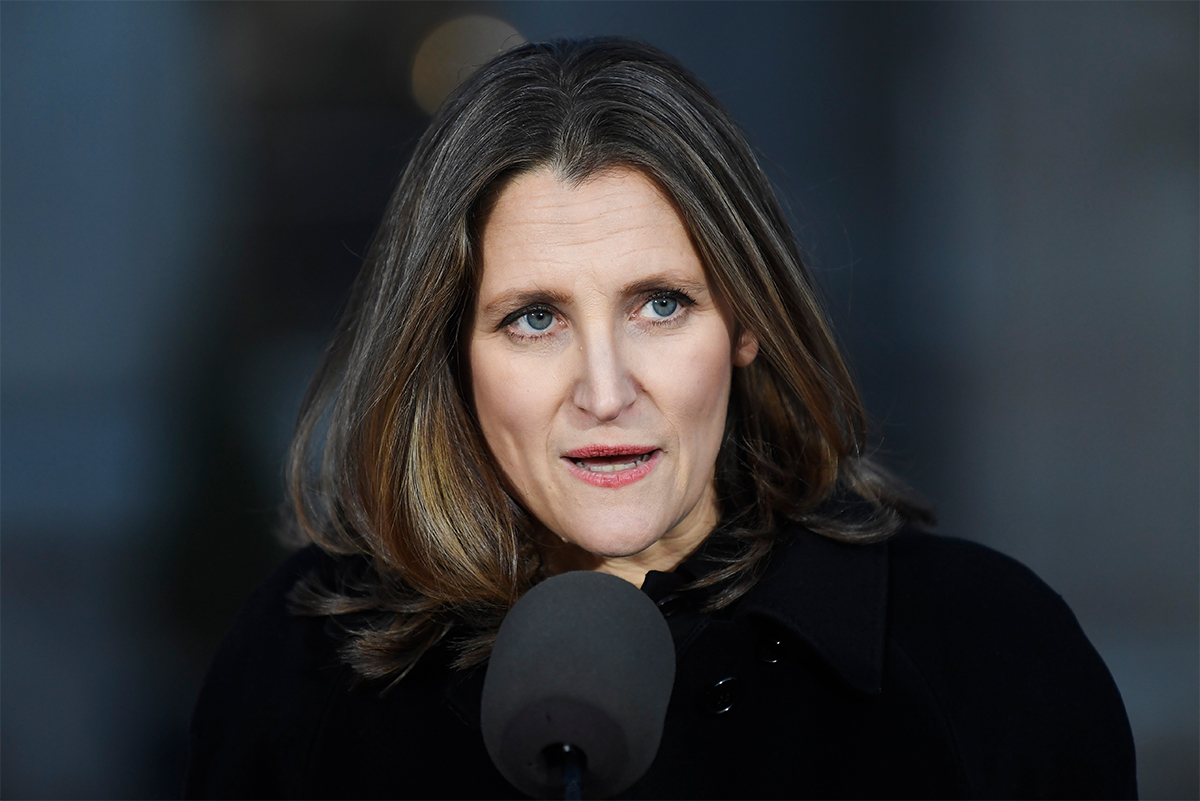Written by Peggy Nash, Ryerson University. Photo credit THE CANADIAN PRESS/Adrian Wyld. Originally published in The Conversation.
Chrystia Freeland, newly named deputy prime minister and minister of intergovernmental affairs, speaks following the swearing-in of the new cabinet at Rideau Hall in Ottawa.
The new Liberal cabinet has mostly familiar faces, with just a few shuffled deck chairs and some new ministers.
Much of the focus has landed on Chrystia Freeland, the new minister of intergovernmental affairs and deputy prime minister.
Freeland is clearly Justin Trudeau’s most powerful minister, with a bundle of political problems on her plate. Regional tensions are brewing across Canada and she will need all her negotiating skills to forge solutions.
So is this a promotion for the high-profile former foreign affairs minister who spearheaded the negotiations with U.S. President Donald Trump’s team to nail down a new NAFTA, and who told the world that Canada had returned as an important middle power and defender of women and all human rights?
Or is this a dead end, a no-win situation where she will now be the lightning rod for anger across the land?
The Liberals were elected in 2015 to a majority government after an aspirational campaign that focused on middle-class prosperity and aimed to restore Canada’s place in the world.
Due to their majority, the Liberals could pass confidence bills like the budget or initiatives like the assisted suicide law or the legalization of marijuana provided they accepted some input and tweaking from the Senate.
They could also block what they didn’t want, especially at committees, such as the shutdown of the SCN-Lavalin inquiry.
A new reality
Trudeau’s new minority government in 2019 now faces a different reality.
The Liberals looked vulnerable to defeat in the wake of a number of ethics scandals, the expulsion from the Liberal Party of two key women cabinet ministers, the leader’s multiple blackface and brownface episodes and backtracking on election promises such as effective climate change action, Indigenous reconciliation and electoral reform.
Arguably, the Liberals won in part by demonizing Conservative Leader Andrew Scheer, who ran a weak campaign, and by linking him to Ontario Premier Doug Ford and Trump. Many people voted Liberal out of fear, but the Conservative Party actually won the most votes.
The Liberals were reduced to a minority government as regional divisions flared. The Bloc Québécois won 32 seats after a surprisingly strong election campaign by BQ Leader Yves-François Blanchet, and the Liberals were shut out of Alberta and Saskatchewan.
A “Wexit” separatist movement has now emerged, with Alberta Premier Jason Kenney throwing gas on the flames of western anger and alienation.
Collaboration required
To pass bills now, the Liberals will need to negotiate with other parties. Many votes will depend on regional priorities. For example, if the Liberals decide to take greater action on climate change, they can likely win support from the NDP and the Bloc.
But the West wants action on pipelines and job creation. Squaring this circle on the environment and the economy, the West and the rest of Canada will be this government’s biggest challenge. This is where the Alberta-born Freeland comes in.
Many women, in particular, are cheering Freeland’s high-profile appointment and wish her well. Women remain greatly under-represented in Canada’s Parliament at 29 per cent, edging up slightly from the 26.9 per cent of the previous parliament by electing 10 more women, but still trailing more than 50 other countries in women’s representation, according to the Interparliamentary Union organization.
Significant barriers still confront women who want to get elected to public life. The danger, of course, is that often when women get to the top or near the top of an organization, they can face either a glass ceiling or a cliff. Most women premiers in Canada don’t get re-elected.
Canada’s first woman prime minister, Kim Campbell, was elected by Conservative convention delegates. But left to face the fury of voters towards the government of Brian Mulroney, she led the party to a crushing defeat with just two seats in 1993.
So whether this new position is a promotion or a dead end for Freeland depends on where party and regional alliances can be built.
Skilled negotiator
As we saw in the North American free-trade negotiations, Freeland is a talented negotiator. But she will need to check herself on her tendency to lecture others. Kenney and Saskatchewan Premier Scott Moe are in no mood for virtue lecturing by federal Liberals.

While Freeland is the third woman to be named deputy prime minister, it’s unclear whether this role will be simply ceremonial or more substantive. The latter would be better suited to Freeland. And her role as minister of intergovernmental affairs, a job that prime ministers often keep for themselves, suggests she’ll have lots of room for breaking new ground.
However, the deputy prime minister role doesn’t necessarily lead to the top job. In fact, no deputy prime minister has ever gone on to lead the country. Many see Freeland as ambitious and a possible successor to Trudeau. So does this position favour that aspiration?
Time will tell. And women will be watching.

